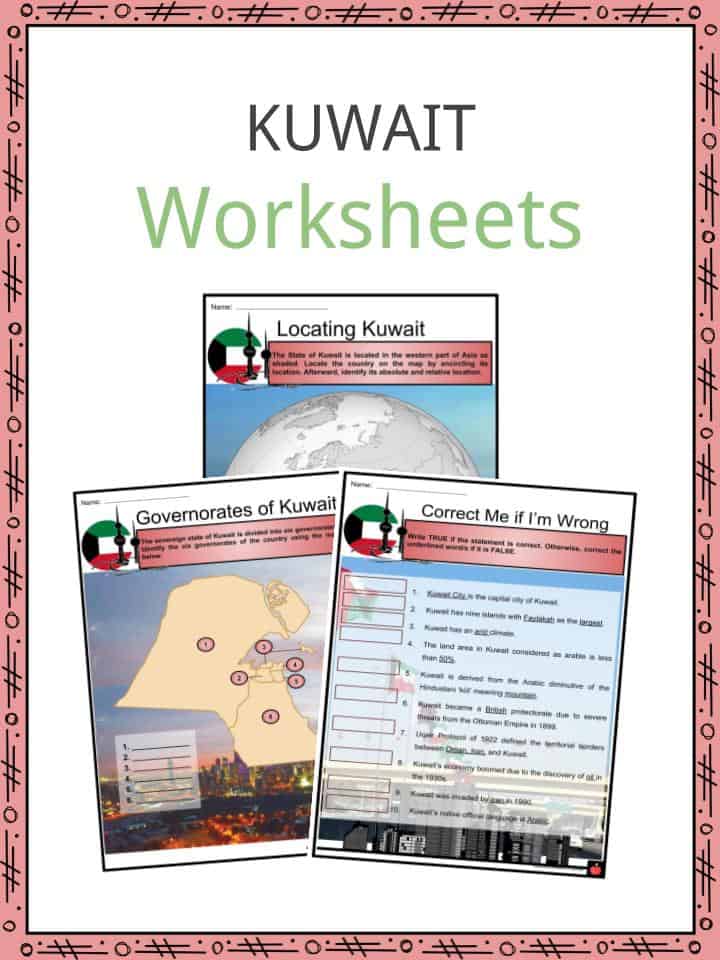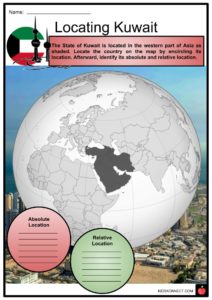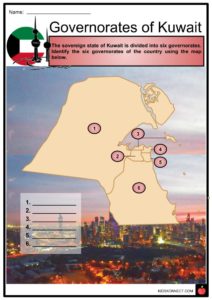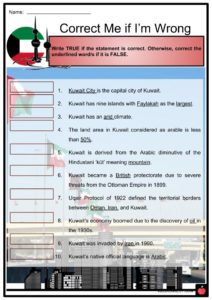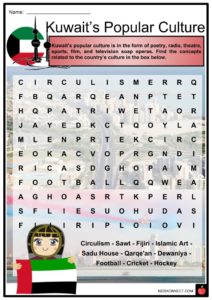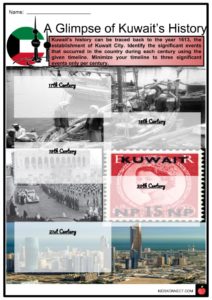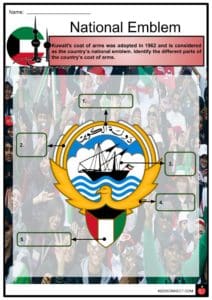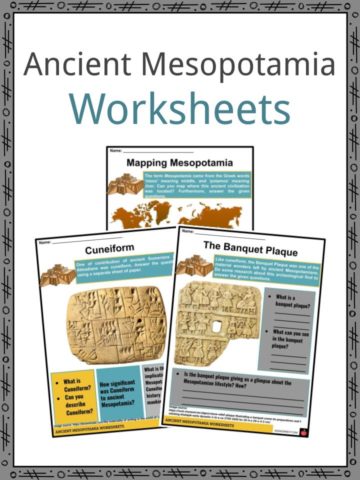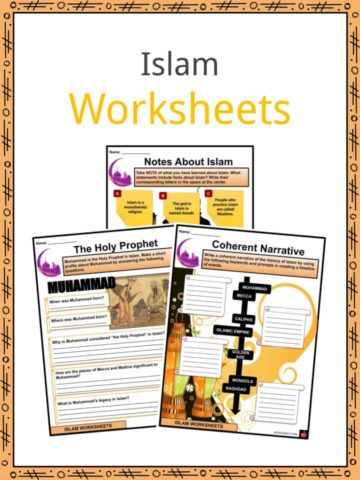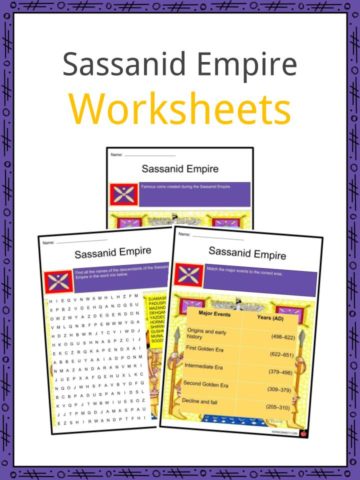Download This Sample
This sample is exclusively for KidsKonnect members!
To download this worksheet, click the button below to signup for free (it only takes a minute) and you'll be brought right back to this page to start the download!
Sign Me Up
Table of Contents
Kuwait, formally the State of Kuwait and originally known as Kureyn, is a country in Western Asia. The Arabic diminutive of the Hindustani kūt (“fort”) is where the name Kuwait derives. The majority of Kuwait’s population lives in Kuwait City, making it one of the most urbanized countries in the world.
See the fact file below for more information on Kuwait, or you can download our 24-page Kuwait worksheet pack to utilize within the classroom or home environment.
Key Facts & Information
History
- The majority of today’s Kuwait was formerly a part of ancient Mesopotamia.
- Kuwait served as the focal point for interactions between Neolithic Eastern Arabians and Mesopotamian peoples during the Ubaid period (6500 BCE).
- Alexander the Great led the Greek colonization of Kuwait Bay in the 4th century BCE. The Greeks gave the mainland of Kuwait the name Larissa and Failaka the name Ikaros. Failaka Ikaros was given that name by Alexander the Great because it resembled the corresponding Aegean island in terms of size and shape.
- Kuwait was a part of the Parthian Empire in 127 BCE, and the kingdom of Characene was founded near Teredon, which is now in modern-day Kuwait.
- Kuwait joined the Sassanid Empire in 224 CE. Kuwait was known as Meshan during the Sassanid era, which was another name for the kingdom of Characene.
- The Banū (Banī), a group of families from the Anizah nation in the interior of the Arabian Peninsula, are thought to have migrated to the region that is now Kuwait at the beginning of the 18th century.
- Kuwait became a prosperous independent trading community in the 19th century. ʿAbd Allāh II, who ruled Kuwait from 1866 to 1992, started to bring his kingdom closer to the Ottoman Empire at the end of the century but never actually dominated it.
- The first Iraqi claim to Kuwait appeared in 1938 when the emirate’s oil was discovered. Iraq asserted a hazy historical title even though neither it nor the Ottoman Empire had ever truly governed Kuwait. It also provided some verbal support to a merchant insurrection against the emir that year. After the Majlis Movement rebellion, which was unsuccessful, Iraq continued to assert a claim to at least a portion of Kuwait, particularly the vital islands of Bibiyn and Al-Warbah.
- Britain acknowledged Kuwait’s independence on June 19, 1961. However, six days later, Iraq reaffirmed its claim, which was rejected by troops from the Arab League and the British government. A new Iraqi government did not legally acknowledge Kuwait’s independence or subsequent borders until October 1963, although continuing to push for access to the islands.
- The 1980–88 Iran–Iraq War seriously threatened Kuwait’s security. Iran launched an assault on a Kuwaiti refinery facility in 1981, which sparked sabotage attempts in 1983 and 1986.
- Iran started focusing its attacks on gulf shipping, mostly on Kuwaiti tankers, in September 1986. This prompted Kuwait to request protection for its tankers from the Soviet Union and the United States in early 1987.
- Iraqi-Kuwaiti ties worsened in 1988, following the conclusion of the Iran-Iraq War. The Persian Gulf War began on August 2, 1990, when Iraq suddenly invaded and seized control of the nation.
Economy
- One of the richest nations in the world is Kuwait, with a wealthy petroleum-based economy. The Kuwaiti dinar is the world’s most valuable currency unit. According to the World Bank, Kuwait is one of five countries with a GNI per capita above $70,000, making it one of the five richest countries.
- Iraq was Kuwait’s leading export market in 2019, and food and agricultural products made up 94.2% of all export commodities. Sulfonated, nitrated, and nitrosated hydrocarbon exports from Kuwait were the highest in the world in 2019.
- Currently, Kuwait is considered the oil-dependent country in the region with the least amount of economic diversification.
Education
- In 2010, Kuwait had the highest rate of literacy in the Arab world.
- All students between the ages of six and fourteen must attend primary and intermediate school. Higher education is accessible at all levels of public education.
Tourism
- Kuwait spent $6.1 billion on domestic travel and tourism in 2020, with family travel representing a rapidly growing industry. Kuwait had an 11.6% year-over-year growth in travel and tourism GDP in 2019, according to the World Travel and Tourism Council (WTTC), making it one of the world’s fastest-growing countries.
- Tourism to Kuwait is growing for several reasons, including the fact that it is an engaging and fascinating location. A few examples include the distinctive architecture, fascinating museums, beautiful beaches, and rich culture.
- There are a few crucial things to be aware of before visiting Kuwait. Being a conservative country, Kuwait forbids several standard practices in the west but not there. Before visiting Kuwait, you must have the proper travel papers.
Transport
- Kuwait’s highway system is comprehensive and modern.
- The majority of the country’s bus routes make up its public transportation system.
- Over two million passenger cars, 500,000 commercial buses, trucks, and taxis are in use. The top speed limit on major highways is 120 km/h (75 mph). Since the country has no railway system, most people commute by car.
Demographics
- There were 4.6 million people living in Kuwait in 2018, of whom 1.8 million were Kuwaitis, 800,000 were other Arabs, 1.6 million were expatriates from Asia, and 47,227 were Africans.
Religion
- Maliki Sunni Islam is the recognized official religion of Kuwait. There is no official national census, although it is estimated that 60%–70% of Kuwaiti people are Sunnis and 30%–40% are Shia. The majority of Kuwaiti citizens are Muslims. There is a native Christian community in the country, which is estimated to number between 259 and 400 Christian Kuwaitis.
Languages
- Arabic is the native and official language, and proficiency in it is necessary for naturalization. Kuwaitis use a Gulf Arabic dialect, and modern standard Arabic is taught at educational institutions. In public schools, English is taught as a second language. The immigrant community also speaks a lot of other languages, including Hindi, Urdu, Persian (Farsi), and others.
Culture
- Kuwait’s theater, radio, music, and television soap opera industries all thrive and are even exported to its neighbors. Kuwait’s culture is the Gulf Arab nation’s closest to Bahrain’s, as seen by the two nations’ frequent collaboration on stage productions and television soap operas.
Performing Arts
- Kuwait has the oldest performing arts sector in the Arabian Peninsula. Kuwait’s television drama industry is the most notable and thriving Gulf Arab drama industry is Kuwait’s television drama industry, which yearly cranks out at least fifteen serials. The main production center for Gulf television comedies and dramas is Kuwait.
- Kuwait has a long-standing national theater tradition. Kuwait is the only country in the Gulf Arab region with a theatrical history. In Kuwait, theater plays a major role in the culture of the country. Since the introduction of the first spoken dramas in the 1920s, Kuwait has had a thriving theater scene.
Visual Arts
- In the Arabian Peninsula, Kuwait has the oldest modern art movement. The first known visual artist in the Gulf Arab region was the Kuwaiti artist Mojeb al-Dousari. In the region, he is credited with founding portraiture.
- There are more than 30 art galleries in Kuwait. The Al Qurain Cultural Festival and the Formative Arts Festival are some of the festivals that the government organized.
Cuisine
- Arabian, Iranian, and Mesopotamian cuisines have been combined to create Kuwaiti cuisine. Eastern Arabian cuisine includes Kuwaiti food.
- Machboos is a popular dish in Kuwaiti cuisine. It is a rice-based dish usually made with chicken or mutton and basmati rice that has been spiced.
- The Kuwaiti diet includes a lot of seafood, especially fish.
- Iranian khubz is the name of the traditional flatbread in Kuwait. It is a sizable flatbread prepared in a unique oven and frequently sprinkled with sesame seeds.
Sport
- In Kuwait, football is the most popular sport. The Kuwaiti football league is overseen by the Kuwait Football Association (KFA).
- The sport of basketball is one of the most popular in the country. The Kuwait Basketball Association (KBA) oversees the national basketball team of Kuwait. In 1959, Kuwait made its debut on the world stage. Eleven times, the national basketball team has competed in the FIBA Asian Championship.
Kuwait Worksheets
This is a fantastic bundle that includes everything you need to know about Kuwait across 24 in-depth pages. These are ready-to-use Kuwait worksheets that are perfect for teaching students about the State of Kuwait, which is a sovereign country in West Asia on the northwestern part of the Persian Gulf. Situated in the northeastern part of the Arabian Peninsula, Kuwait has a desert topography; however, despite having the least-hospitable desert, the country is rich in oil.
Complete List Of Included Worksheets
- Locating Kuwait
- Governorates of Kuwait
- Correct Me If I’m Wrong
- Kuwait’s Popular Culture
- A Glimpse of Kuwait’s History
- National Emblem
- Kuwait’s Economic Resources
- The Latest from Kuwait
- Exploring Kuwait
- Kuwait’s Legacy
Frequently Asked Questions
Is Kuwait a rich country?
Kuwait is one of the richest countries in the world, with a wealthy petroleum-based economy. The Kuwaiti dinar is the world’s most valuable currency unit. According to the World Bank, Kuwait is one of five countries with a GNI per capita above $70,000, making it one of the five richest countries.
What is Kuwait famous for?
Kuwait has a long-standing national theater tradition. Kuwait is the only country in the Gulf Arab region with a theatrical history. In Kuwait, theater plays a major role in the culture of the country. Since the introduction of the first spoken dramas in the 1920s, Kuwait has had a thriving theater scene.
Is Kuwait a strict country?
There are a few crucial things to be aware of before visiting Kuwait. Being a conservative country, Kuwait forbids several common practices in the west but not there. Before visiting Kuwait, you must have the proper travel papers.
Which country owns Kuwait?
Britain acknowledged Kuwait’s independence on June 19, 1961. However, six days later, Iraq reaffirmed its claim, which was rejected by troops from the Arab League and the British government. A new Iraqi government did not legally acknowledge Kuwait’s independence or subsequent borders until October 1963, although continuing to push for access to the islands.
What language is spoken in Kuwait?
Arabic is the native and official language, and proficiency in it is necessary for naturalization. Kuwaitis use a Gulf Arabic dialect, and modern standard Arabic is taught at educational institutions. In public schools, English is taught as a second language. The immigrant community also speaks a lot of other languages, including Hindi, Urdu, Persian (Farsi), and others.
Link/cite this page
If you reference any of the content on this page on your own website, please use the code below to cite this page as the original source.
Link will appear as Kuwait Facts & Worksheets: https://kidskonnect.com - KidsKonnect, October 11, 2018
Use With Any Curriculum
These worksheets have been specifically designed for use with any international curriculum. You can use these worksheets as-is, or edit them using Google Slides to make them more specific to your own student ability levels and curriculum standards.
